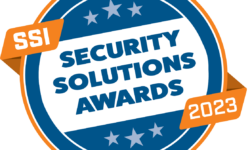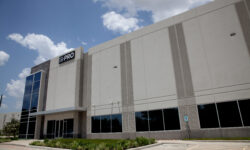Need-to-Know Nuances of Networked Solutions: Trends in EAC & BAS
Never has the adage the whole is greater than the sum of the parts been more on the nose. Find out what’s achievable by marrying networked access control and building intelligence systems.

(Image: naruecha/stock.adobe.com)
The network effect is a transformative phenomenon that previous generations will not have known, yet it has shaped modern life in countless ways and will likely continue to have a massive impact on our future.
In the past 50 years alone, we’ve evolved from signal transport to control to data. We’ll soon see the proliferation of autonomous networks, and the next potential stop: neural networks.
The power of intelligent connected devices and the scope of data collected by these devices is growing every day. In the process, buildings will become smarter, businesses more efficient, populations safer, and comfort and convenience will be more broadly attainable than previously imaginable.
The power of networks increases with every new node and each new event. Systems become ecosystems that get smarter and more useful with each additional device or sensor event.
Pairing EAC and BAS
The industrial Internet of things (IIoT), Web 3.0 and a host of new, emerging technologies will shape and reshape the smart home, commercial building, education, healthcare and smart city experience as well as electronic access control (EAC).
Together, these technologies — at the nexus of physical and networked worlds — will be the theater of innovation, integration and advanced user experiences.
Significant progress on this front is being made with the pairing of building management and access control systems. Depending on the number of people that an access control system “knows” are in a building space, for example, the more data it can feed the building’s management system to regulate temperature and lighting.
It might need to change how much airflow there is in a particular area of an office for better filtration or add more air conditioning as more and more bodies occupy a space. Not only can this promote greater comfort and healthier, more productive surroundings, but it also creates opportunities for greater energy efficiency.
EAC already provides convenient ways to authorize and activate safe entry into secured areas. There’s no question that integrated software solutions will continue to make even smarter use of access authorization, sensing, and audit trail data.
For instance, an employee badging in to enter through a parking gate after hours could trigger lights to turn on between the person’s parking spot and office, intelligently and safely lighting the way. As we look at things like elevator control, destination dispatch and intelligence, people badging into a lobby kiosk could be directed to shared elevator cars going to common or adjacent floors.
That could translate into less square footage required inside the core of the building and a more sustainable and efficient way of moving people through the building. Again, we’re pairing access control intelligence with building systems. We’re seeing this more and more, especially in smart buildings, smart campuses and smart cities.
Over the course of time, as more sensing and more data becomes available, we’ll be able to use it to make these intelligent decisions throughout a building or campus. Information about temperature, physical security, logical security, cybersecurity and network management can be merged into robust building intelligence.
The impact is immediately noticeable. Authorized personnel move freely from zone to zone and data powers learning that makes the building and its experience even better. As the experience improves, so do the economics of running the building.

The power of networks increases with each new node and event. Systems become ecosystems that get smarter and more useful with each added device or sensor event. (Image: BullRun/stock.adobe.com)
Advanced Applications
During the past two years, we’ve seen the commercial sector increasingly mine access control and security management data for intelligence. For example, say you have a parking garage in your office building and pay for X number of spots. Are they being used? Are people actually coming to this building?
Maybe you’ve got three buildings in an urban environment. Are all three buildings getting the same amount of use? Are all three parking garages maximized and being used wisely? Mining this data intelligently allows you to make more informed real estate and management decisions.
Ultimately, the goal is to take the available data and use it as a sensor and as an input to make either machine learning decisions, artificial intelligence decisions or just enable more people to make more intelligent decisions with real-time data about their situation.
Space optimization took on additional urgency and presented new opportunities during the pandemic. Case in point is the hoteling of spaces in both commercial and institutional facilities. The workforce is much more remote than it’s ever been, but people are certainly still coming in and out of the office every several days.
So how can we hotel them into a spot? How can we provide them a location to sit and plug in and to have that desk phone ring with their phone number for the time that they’re in the space? Then, if they’re off to another location the following week, how can we move that system to where they’ll be?
Again, the access control system knows where they are and knows when they’re coming into a particular office. This can give us a real-time view of where people are. It also allows people to use their existing credentials to unlock a locker that might be needed in a temporary space and/or unlock a desk, office, or conference room for scalable hoteling or hot-desking types of environments.
If we think about this in the context of a campus, we need to consider how to manage guest lecturers, visiting family members, visiting faculty and staff who are coming onto the campus temporarily. How does networked access control allow you to manage that space in the most efficient way?
Looking ahead, how do we start to bring all these different things together to make classrooms, laboratories and residence halls more intelligent?
This is another potential benefit of integrating access control data into building management systems. For example, if there is no one in a room, you could reduce wasted energy by turning off the lights and outlets so that things like chargers that aren’t charging anything don’t continue to draw power.
The temperature set-point for that room might allow it to be a little warmer in the summer or a little cooler in the winter. This can also be tied into scheduling, loss prevention and occupant wellness. The impact of networked access control technologies paired with building management systems promises tremendous gains beyond the building — whether it’s a commercial office space, a school, a hospital or even a home.
Sustainability is central to many corporate, institutional and government brands, organizations and cultures. As we look further into how we can take advantage of some of the sustainability benefits, we can now reduce the amount of power consumed by these systems. We all try to ensure that doors are closed to save energy. This is important to consider when you think about how much heat or air conditioning is lost out of a building on any given day.
KNOW WHAT’S INSIDE THE BOX
Another key element security integrators ought to keep in mind when selecting their networked access control products supplier is the degree to which that manufacturer operates transparently. Seek a technology partner that is most concerned about doing things in a good way and doing them well.
In the case of ASSA ABLOY, the firm has moved to low-power actuators in its different bored, mortise and exit devices and looking at how it builds doors, frames and gaskets around the door. In addition, the company is looking at Health Product Declarations, Environmental Product Declarations and Declare labels so that people using its products know exactly what’s inside them.
According to ASSA ABLOY, it’s now more important than ever to consider how a product is made, how much recycled content is used and whether there are any materials in a product that are red-listed. Visibility into the full list of ingredients in a product allows integrators and facilities to ensure that the materials are in keeping with their standards and align with the architecture, design and sustainability objectives for that space.
Using door operators, door closers and access control in a smart way allows us to know when a door might be propped open and releasing cool or warm air to the outdoors so we can correct that situation quickly. It may even be possible to fix it remotely if that door is using a connected door operator. By adding access control and security management intelligence, organizations can actually improve sustainability.
Onward to Superior Solutions
To capitalize on the commercial opportunity presented by networked access control in a broader building technology/building management system environment, security sales and integration professionals can partner with network and building management providers at the thrust of these new areas of innovation and integration.
Early adopters will be able to take on a leadership role in forging these integrations and certifying the security of these new ecosystems. That means building management companies will be taking direction from publications like this one, and security industry professionals will be drawing innovations from other nonsecurity realms; attending or at least monitoring events from security and nonsecurity segments alike; investing in partnerships with individuals and organizations from adjacent realms and networking with peers in other areas within the building profession.
While not quite the network effect referenced at the beginning of this piece, it’s another example of how 1 + 1 is often greater than 2.
Peter Boriskin is CTO for ASSA ABLOY Americas.
If you enjoyed this article and want to receive more valuable industry content like this, click here to sign up for our FREE digital newsletters!

Security Is Our Business, Too
For professionals who recommend, buy and install all types of electronic security equipment, a free subscription to Commercial Integrator + Security Sales & Integration is like having a consultant on call. You’ll find an ideal balance of technology and business coverage, with installation tips and techniques for products and updates on how to add to your bottom line.
A FREE subscription to the top resource for security and integration industry will prove to be invaluable.







